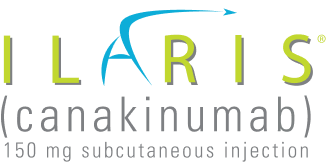
PFS Criteria
Not an actual patient. Individual results will vary.
Detailed classification criteria: PFS (FMF, HIDS/MKD, TRAPS, CAPS)
In general, PFS are characterized by1,2:
Fever with temperatures peaking >39 °C (>102.2 °F) | Rash in varying forms |
Systemic inflammation, often with arthralgia/arthritis | Inflammatory marker elevation |
Eurofever/PRINTO classification criteria3*
Genetic and clinical variables†
FMF classification criteria
Presence of confirmatory MEFV genotype‡ and at least 1 among the following or presence of not confirmatory MEFV genotype§ and at least 2 among the following:
- Duration of episodes: 1-3 days
- Arthritis
- Chest pain
- Abdominal pain
HIDS/MKD classification criteria
Presence of confirmatory MVK genotype‡ and at least 1 among the following:
- Gastrointestinal symptoms
- Cervical lymphadenitis
- Aphthous stomatitis
TRAPS classification criteria
Presence of confirmatory TNRFSF1A genotype‡ and at least 1 among the following or presence of not confirmatory TNRFSF1A genotype|| and at least 2 among the following:
- Duration of episodes is ≥7 days
- Myalgia
- Migratory rash
- Periorbital edema
- Relatives affected
CAPS classification criteria
Presence of a confirmatory NLRP3 genotype‡ and at least 1 among the following or presence of not confirmatory NLRP3 genotype|| and at least 2 among the following:
- Urticarial rash
- Red eye (conjunctivitis, episcleritis, uveitis)
- Neurosensorial hearing loss
Classification criteria were developed by experienced clinicians and geneticists using a multistep process with statistical analyses. Of the 360 patients randomly selected from the Eurofever Registry, consensus was achieved in 281 patients with MKD, TRAPS, PFAPA, FMF, CAPS, and undefined recurrent fevers. Genetic and clinical variables were reported for FMF, HIDS/MKD, TRAPS, and CAPS.
A patient with (1) evidence of elevation of acute phase reactants (ESR, CRP, or SAA) in correspondence to the clinical flares and (2) careful consideration of possible confounding diseases (neoplasms, infections, autoimmune conditions, other inborn errors of immunity) and a reasonable period of recurrent disease activity (≥6 months) is classified as having hereditary recurrent fever if the criteria are met.
Specific diagnostic criteria for CAPS (FCAS and MWS)4¶
Presence of raised inflammatory markers (CRP/SAA) and at least 2 of the 6 typical signs/symptoms:
- Urticaria-like rash
- Cold- or stress-triggered episodes
- Sensorineural hearing loss
- Musculoskeletal symptoms (arthralgia)
- Chronic aseptic meningitis
- Skeletal abnormalities (epiphyseal overgrowth/frontal bossing)
† There are 2 sets of validated classification criteria. One set includes genetic and clinical variables shown above. The second set is based solely on clinical criteria to be used as a potential tool to indicate a need for molecular analysis or if genetic testing is not available.
‡ Pathogenic or likely pathogenic variants (heterozygous in autosomal dominant diseases, homozygous or in trans [or biallelic] compound heterozygous in autosomal recessive diseases).
§ In trans compound heterozygous for 1 pathogenic MEFV variants and 1 VUS, or biallelic VUS, or heterozygous for 1 pathogenic MEFV variant.
|| VUS. Benign and likely benign variants should be excluded.
¶ Criteria enabling physicians worldwide to make a diagnosis of CAPS were developed and validated by an international team of experts using an innovative approach that integrated published evidence, registry expertise, and expert opinion. The proposed model did not mandate evidence of an NLRP3 mutation and had a sensitivity of 81% and a specificity of 94%.
CAPS, cryopyrin-associated periodic syndromes; CRP, C-reactive protein; ESR, erythrocyte sedimentation rate; FMF, familial Mediterranean fever; HIDS, hyperimmunoglobulin D syndrome; MEFV, Mediterranean fever; MKD, mevalonate kinase deficiency; MVK, mevalonate kinase; NLRP3, NLR family, pyrin domain–containing 3; PFAPA, periodic fever, aphthous stomatitis, pharyngitis, and cervical adenitis; PFS, periodic fever syndromes; PRINTO, Paediatric Rheumatology International Trials Organisation; SAA, serum amyloid A; TNFRSF1A, tumor necrosis factor receptor superfamily member 1A; TRAPS, tumor necrosis factor receptor–associated periodic syndrome; VUS, variant of uncertain significance.
References: 1. Hoffman HM, Simon A. Recurrent febrile syndromes—what a rheumatologist needs to know. Nat Rev Rheumatol. 2009;5(5):249-256. doi:10.1038/nrrheum.2009.40 2. Barron KS, Kastner DL. Periodic fever syndromes and other inherited autoinflammatory diseases. In: Petty RE, Laxer RM, Lindsley CB, Wedderburn LR, eds. Textbook of Pediatric Rheumatology. 7th ed. Elsevier; 2016:609-626. 3. Gattorno M, Hofer M, Federici S, et al; Eurofever Registry and the Paediatric Rheumatology International Trials Organisation (PRINTO). Classification criteria for autoinflammatory recurrent fevers. Ann Rheum Dis. 2019;78(8):1025‑1032. doi:10.1136/annrheumdis‑2019‑215048 4. Kuemmerle‑Deschner JB, Ozen S, Tyrrell PN, et al. Diagnostic criteria for cryopyrin–associated periodic syndrome (CAPS). Ann Rheum Dis. 2017;76(6):942‑947. doi:10.1136/annrheumdis‑2016‑209686
